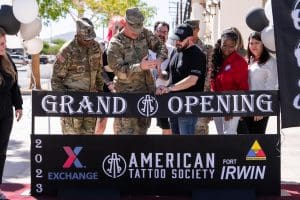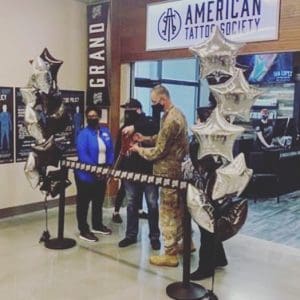 For centuries, tattoos have been an important element of military culture, symbolizing various things such as unit pride and personal service stories. Every division of the U.S. armed forces maintains its own guidelines on tattoos, considering both the urge for personal expression and the importance of maintaining a professional and consistent appearance. Tattoos can serve as a significant form of self-expression and reflection of personal history for military members and veterans. This manual will assist you in understanding the different tattoo regulations in the Army, Navy, Marine Corps, Air Force, and Coast Guard, as well as delving into popular tattoo designs linked with each service branch. Whether you are a novice or an experienced soldier, grasping these rules can guarantee that your tattoos match your military profession.
For centuries, tattoos have been an important element of military culture, symbolizing various things such as unit pride and personal service stories. Every division of the U.S. armed forces maintains its own guidelines on tattoos, considering both the urge for personal expression and the importance of maintaining a professional and consistent appearance. Tattoos can serve as a significant form of self-expression and reflection of personal history for military members and veterans. This manual will assist you in understanding the different tattoo regulations in the Army, Navy, Marine Corps, Air Force, and Coast Guard, as well as delving into popular tattoo designs linked with each service branch. Whether you are a novice or an experienced soldier, grasping these rules can guarantee that your tattoos match your military profession.
 Tattoo Policies by Branch
Tattoo Policies by Branch
Army Tattoo Policy
The Army has recently made its tattoo policy more lenient in order to attract more recruits while still upholding a professional appearance. Soldiers can now have tattoos on their hands, neck (small tattoo only), and behind the ears, as long as the tattoos are not extremist, gang-related, or offensive. Nevertheless, face tattoos remain banned. Every year, commanders check soldiers’ tattoos to make sure they are following the rules. The Army acknowledges the significance of permitting tattoos that reflect soldiers’ individual narratives and unit loyalty while also upholding uniformity and discipline.
Navy Tattoo Regulations
The Navy has one of the most relaxed tattoo policies compared to the other military branches. Sailors can have neck and hand tattoos as long as they are not larger than one inch in diameter. Tattoos located behind the ears are also allowed. The Navy has a historical practice of nautical tattoos such as anchors and swallows and honors this tradition while also enforcing rules against offensive or extremist symbols. Requests for tattoo exemptions are allowed, however, offensive material is not up for discussion.
Marine Corps Tattoo Policy
Recently, the Marine Corps has revised its tattoo regulations to permit more options like sleeves, which were previously not allowed. Marines can have as many tattoos as they want on their arms, as long as they do not go past the wrist bone. However, the rule does not allow tattoos on the face, neck, and hands, except for a single ring-shaped tattoo on a finger. Just like in other sectors, tattoos that have extremist, sexist, or gang-related themes are prohibited.
Air Force Tattoo Rules
The Air Force has relaxed rules to permit small tattoos on hands, necks, and behind ears. Emphasis is placed on upholding a neat look in uniform, therefore, tattoos on the face and head are still not allowed. The tattoo culture in the Air Force frequently showcases aviation themes like fighter jets and wings, representing pride in the branch’s distinctive contribution to national defense.
Coast Guard Tattoo Policy
The Coast Guard permits extensive tattoo coverage like full sleeves, back, and chest tattoos, as long as they are not visible above the crew-neck T-shirt in uniform. Hand tattoos are restricted to only one band on each hand, while tattoos on the face are still not allowed. Similar to the other branches, the Coast Guard bans tattoos that contain offensive or extremist material.
 Military Tattoo Styles
Military Tattoo Styles
Army Tattoo Styles
Military tattoos frequently include guns, birds of prey, and symbols of rank in the armed forces. Soldiers often get tattoos to remember their units, battles, or fellow soldiers. Some common designs are crossed rifles, dog tags, and the American flag. These tattoos frequently act as a enduring memory of the soldier’s dedication and individual sacrifice.
Navy Tattoo Styles
Traditional Navy tattoos often feature anchors, ships, and nautical stars as popular designs rooted in tradition. Numerous sailors also choose to get tattoos that symbolize their journeys, like swallows (standing for 5,000 nautical miles traveled). Tattoos showing mermaids, sharks, and shipwrecks are frequently seen in Navy tradition, symbolizing the risks and excitement of life on the ocean.
Marine Corps Tattoo Styles
The well-known tattoo of the “Globe and Anchor” is closely associated with the Marine Corps. Additional common designs are skulls, combat symbols, and the Marine Corps motto, “Semper Fi.” A lot of Marines choose to get tattoos as a way to remember their fallen friends or to mark their time in service. These designs showcase the Marine’s strong bond of brotherhood and pride.
Air Force Tattoo Styles
Tattoos commonly found among Air Force members typically feature aviation motifs like wings, fighter jets, and planes. Airmen often choose to get tattoos of the American flag, bald eagles, and unit patches. These patterns represent the pilot’s link to flying and protecting the country, and frequently show a strong feeling of honor in the Air Force’s goals.
Meaning of Military Tattoos
Military tattoos frequently have significant symbolism, reflecting important events in a soldier’s time in the military. Frequent motifs consist of tattoos that serve as memorials for deceased comrades, icons of patriotism such as the American flag, and tattoos that represent personal accomplishments, like unit patches or rank insignia. Tattoos can help veterans adjust to civilian life by serving as a lasting memory of their time in the military. Soldiers often get memorial tattoos like the “battlefield cross” to honor the sacrifice of their comrades in arms.
FAQ Section
1. What tattoos are allowed in the military?
Each branch has different rules, but generally, tattoos that are obscene, extremist, or gang-related are prohibited. Facial tattoos are restricted in all branches.
2. Can I join the military if I already have tattoos?
Yes, as long as your tattoos meet the branch regulations you are joining. Some tattoos may require waivers.
3. What happens if I get a tattoo that violates military policy?
Depending on the branch, you may be required to have the tattoo removed, modified, or covered up. Non-compliance can result in disciplinary action.
4. Are there restrictions on tattoo size or location?
Yes, visible tattoos on the face, neck, and hands are restricted, though small hand and neck tattoos are now allowed in some branches.
5. Can tattoos affect my military career?
Yes, certain tattoos may limit eligibility for special assignments or promotions, especially if they are visible in uniform.
Conclusion
Tattoos are now deeply ingrained in military culture, enabling soldiers to showcase their identity, remember their time in service, and pay tribute to their fellow soldiers. Although every branch has its own rules, recent changes have relaxed tattoo regulations to align with evolving societal values. It’s crucial to stay knowledgeable about the guidelines for your military branch when getting a new tattoo or adjusting an old one to meet standards. For assistance with military-approved tattoo designs, stop by American Tattoo Society and consult with our skilled artists to craft a design that showcases your service while adhering to regulations.
